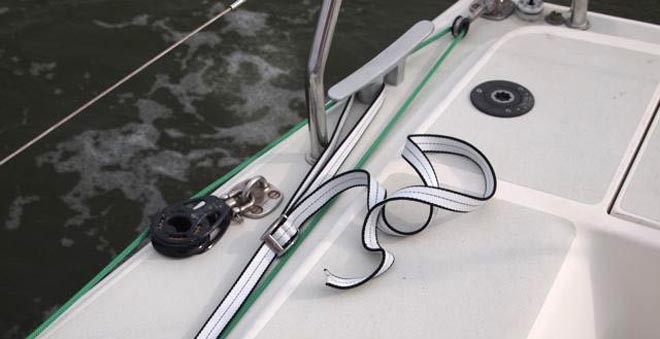Jackstays and Jacklines- The options for the cruising sailor
by Sail-World Cruising on 20 Jul 2012

Jacklines - must be tied off sufficiently to provide complete security SW
How should Jackstays or Jacklines be used on a yacht most effectively? What should they be made of? Should they be taut and act as a ‘third leg’ to steady a person moving along deck while holding their tether tightly in hand? Or should the Jackline and tether be there to catch a person should they fall?
Which you favour is actually the owner's choice and maybe both can be incorporated into the one line.
There is also an ongoing discussion whether the amount of stretch in webbing jacklines (estimated by some to be 20%) is dangerous?
Remember that an overboard person attached to a webbing jackline could very well wind up being towed astern if the jackline stretches and the tether attached to it is full length (6ft).
Some have suggested that this could be prevented or reduced by attaching the after end of the jackline at least 6 feet forward of the transom.
Another discussion that favors webbing over wire jacklines is that webbing is generally a contrasting color and it does not roll under foot. Webbing jacklines are prone to more chafing and sun/UV damage than wire, which means that it needs replacing often.
In the racing world some event organizers around the world allow line instead of webbing as long as it has a breaking strength of 4500 lb or greater. Others will not accept nylon jacklines of any type. One, (Sydney to Hobart) requires that the jacklines be made of 12 mm low/no stretch spectra material.
A possible compromise that might be acceptable is to insert a low/no stretch line inside the tubing of a webbing jackline.
Tips on Jackstays (or Jacklines), Clipping Points and Static Safety Lines:
1. Jacklines should be attached to through-bolted or welded deck plates on the port and starboard sides of the center line. They are to provide secure attachments for safety harness tethers. These lines should be made of uncoated stainless steel wire or webbing of equivalent strength. Multihulls should have at least two jacklines fitted on the underside in case of inversion.
2. Clipping Points for harness tethers should be attached to through-bolted or welded deck plates or other strong anchorage points adjacent to stations such as the helm, sheet winches, and masts, where crew members work for long periods. If you have a full crew then two-thirds of the crew should be able to be clipped onto clipping points simultaneously, without depending on jacklines.
3. Most importantly static safety Lines together with jacklines and clipping points must enable crew to
clip on before coming onto deck and unclip after going below. While continuously clipped on, crew must be able to move readily between working areas and in cockpit(s), including being able to cross the deck athwart ships, with a minimum of clipping and unclipping.
We would like to thank and acknowledge www.ussailing.org!US_Sailing for their contribution to the information in this article
If you want to link to this article then please use this URL: www.sail-world.com/99918